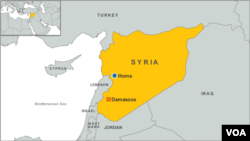Despite facing severe threats in northern Syria from Turkish and U.S.-led coalition airstrikes, and Kurdish-led forces threatening their de-facto capital of Raqqa, Islamic State extremists are expanding an offensive in central Syria.
In typical counter-punch fashion, the extremists are using force mobility to open up new fronts to surprise opponents. In recent weeks the group, also known as ISIS or ISIL, has mounted a series of attacks on a Syrian airbase 90 kilometers east of Homs and on villages in the countryside around the country’s third largest city, say local political activists and rival Syrian militias.
They are “highly mobile fighters ... able to switch the direction of their attacks” quickly, according to Scott Atran, an anthropologist who specializes in jihadi organizations.
The messy triangular fight in the center of the country is drawing less media attention than battles elsewhere in the north and south of war-torn Syria. But the geographic, strategic and economic importance of the city and surrounding province dictate the endgame of the four-year-long civil war will likely dawn in the fertile agricultural region along the Orontes River Valley, the gateway from Syria's Mediterranean coast to its interior.
It is also roughly halfway between Damascus and Aleppo, and close to Lebanon.
The Tiyas base, one of the largest military airports controlled by the regime of President Bashar al-Assad, has come under several attacks in recent weeks from Islamic State militants. Late last month at least 20 Syrian soldiers were killed or wounded in a twin-bombing near the air base in Syria’s central province, according to a monitoring group.
The British-based Syrian Observatory for Human Rights, which gathers information from activists on the ground, said the explosions were followed by fierce gun-battles between the Islamic State and Syrian troops, near the airbase, also known as T4.
The airport reportedly hosts military advisers and technicians from Assad allies Russia and Iran, a helicopter squadron and three fighter-bomber squadrons, including one of Russian-supplied Sukhoi Su-24M2s. U.S. defense officials consider the Su-24M2s the most important air asset of the Assad regime.
For weeks, ISIL militants and Syrian forces have skirmished in the countryside to the east of Homs. On Monday, political activists reported violent clashes between regime forces and Islamic extremists around the Jazal oilfield to the west of Palmyra, the ancient desert town boasting one of the world’s most important Roman archaeological sites that ISIL captured in May. Along with Palmyra, ISIL seized the modern adjacent town of Tadmur, also capturing another major airbase.
Caught off guard
The fall of Palmyra-Tadmur was speedy, the regime appeared to be caught off guard and mounted a poor defense. But the Syrian army last month launched an offensive and claims elite Special Force units have made progress in seizing back outlying areas of Palmyra. ISIL commanders have responded with bombing runs and gun battles around the T4 military airport and a natural gas-pumping station.
The regime has been responding to ISIL attacks by unleashing barrel bombs on Islamic extremists and Syrian rebel militias in the countryside around Homs, the latest wave coming Tuesday on Rastan, say U.S. defense officials.
Jonathan Schanzer, an analyst with the Foundation for the Defense of Democracies, says the jihadis “need to continue to conquer territory in order to survive” faced as the group is with dwindling resources and the U.S. targeting of its oil fields.
For all sides in the four-year-long civil war, Homs represents a crucial as well as a symbolic prize. Dubbed the "capital of the revolution" after residents embraced the call to overthrow the Syrian president in early 2011, much of the city fell under the control of the rebels for the first two years of the war until May 2014 when the government re-established control.
Syrian rebels are eager to grab it back from Syrian government forces. For Islamic State, making headway in the city would be a symbolic gesture for a group that is always keenly conscious of symbolism. Homs was first captured by Muslims in the seventh century, when Umar ibn Al-Khattab, considered one of the greatest caliphs, seized it from Byzantine Christians and sun-worshippers.
But the city and province of Homs are major strategic pieces on the chess board for all sides, control of the center of Syria opens the route to the Mediterranean coast for the rebels and Islamic State. And for the regime, Homs dominates the corridor linking the capital of Damascus to the coastal strongholds of President Assad’s minority Alawi sect. “With Homs, the road is open to Damascus for us to link with southern militias and to besiege the capital,” says rebel commander Abdul Rahman.












